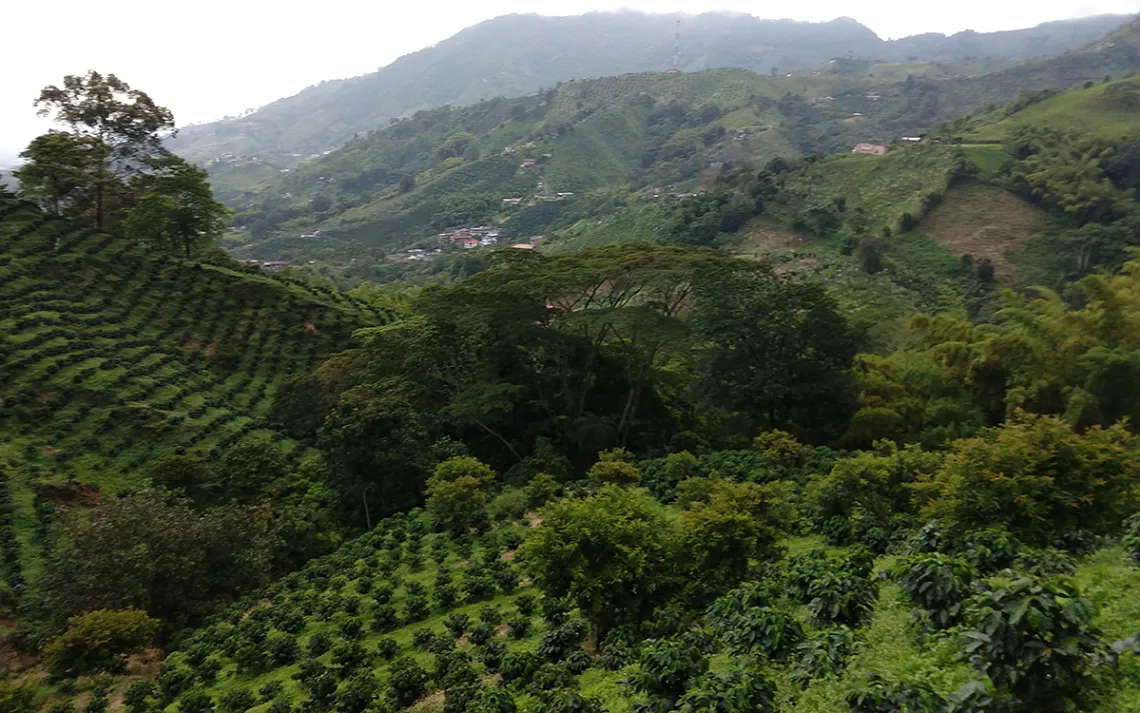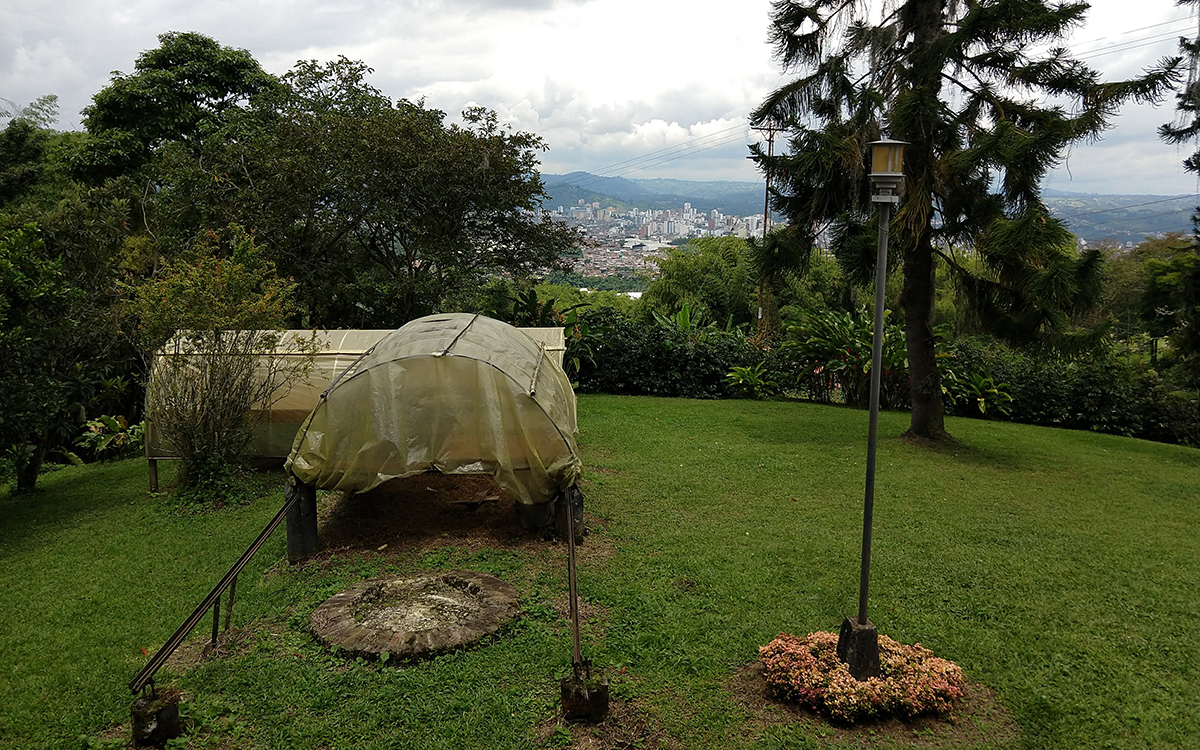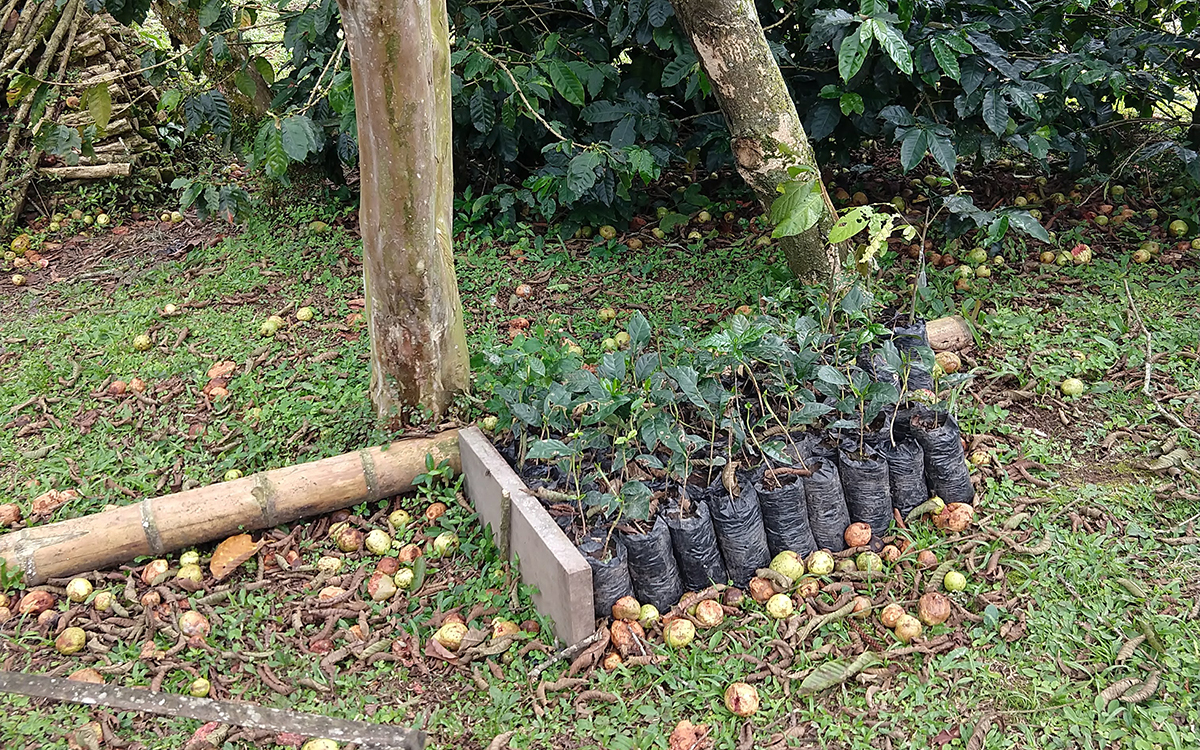Climate Adaptation in Coffee Country
A social scientist considers the roots of Colombian farmers’ woes

Photos courtesy of Natalie White
Maria stared at me over the rickety table of an open-air restaurant in the Andean mountains of the Colombian coffee axis. Feeling lightheaded, I politely declined another offer of coffee. On this, my second research trip to Risaralda, I rued the irony of studying a beverage I can’t drink—caffeine compounds my altitude sickness.
Maria and I had been chatting about her experience as a coffee farmer coping with both a changing climate and a civil conflict that had left this region largely cut off from the wider world until about a decade ago. Maria has been farming coffee for more than 50 years, since she left elementary school in second grade. Like many of the farmers in this region, she has a vast repository of knowledge garnered from her coffee-farming grandparents, parents, and neighbors, and her experience with her land.
As a Purdue University social scientist who focuses on communication, I was here with three Colombian researchers from the Universidad Tecnológica de Pereira to learn about the social aspects of climate change impacts in this region (the full names of coffee farmers who participanted have been withheld to protect their anonymity). How do Colombian coffee farmers learn about climate change? How would they like to receive information on adaptation strategies? How do they describe their firsthand experiences with a changing climate?
Our first round of data collection—which entailed 45 in-person interviews with coffee farmers conducted by an international team of four researchers—had revealed several prominent themes. We sought as representative a sample as possible for the region, interviewing two to four farmers in each of Risaralda’s 14 municipalities. To these farmers, climate change means that the seasons to which they were once accustomed—winter (what they call the rainy season) and summer (the sunny season)—were no longer following a reliable schedule. Some had been observing this for several years, others for more than a decade. This unreliability, they say, makes it difficult to plan production decisions and reduces coffee yields, which in turn brings down their sales. What’s more, extreme weather events—heavy rains, extended droughts—were damaging their crops.
The point of this second round of data collection was to ensure we were capturing the whole picture. As I told Maria our research findings, she politely explained where our research was missing the mark. The much-needed climate change adaptation we were studying wouldn’t take priority until the farmers’ “bigger problem” was solved: poverty. The hallmarks of day-to-day financial precariousness—loan sharks, unpredictable coffee sale prices, poor crops, no insurance—had led to her recent hospitalization from stress-induced illness.
 Maria’s situation points to a conundrum my research team encountered again and again: We can't contend with climate change adaptation until we contend with the poverty that has been plaguing farmers for generations. None of the farmers we interviewed felt they had a reliable source for weather forecasts, for instance. The majority didn’t access the internet regularly. Most relied on neighbors, family, self-organized associations, and television for climate change information. World-of-mouth was their preferred method of information exchange.
Maria’s situation points to a conundrum my research team encountered again and again: We can't contend with climate change adaptation until we contend with the poverty that has been plaguing farmers for generations. None of the farmers we interviewed felt they had a reliable source for weather forecasts, for instance. The majority didn’t access the internet regularly. Most relied on neighbors, family, self-organized associations, and television for climate change information. World-of-mouth was their preferred method of information exchange.
In Risaralda, climate change is not part of the local agricultural outreach service’s educational agenda. The National Federation of Coffee Growers of Colombia, a nongovernmental organization that is financially supported by the Colombian federal government, runs the service—known locally as “extension.” It is unsurprising, therefore, that the vast majority of our interviewees reported that no one prepared them for climate change, and that they need more information about the issue. At some point, this educational agenda will need to change.
All of this is great information to have. But, as Maria pointed out, we were missing the point. For many of these small-holder coffee farmers who hand-pick their beans on only several acres of land, climate change is compounding the most pressing problem of poverty, which interrupts production and decreases crop yields. For many of Colombia's 300,000 coffee producers, climate change is just one more layer of insecurity layered over an already-insecure existence. Many of our interviewees echoed the same story. It isn't that they aren't aware of climate change—all 45 of our interviewees had heard the term. It isn't that they don't see the impacts—more than 95 percent could describe unusual climatic interruptions they hadn’t seen several decades ago. And it isn't even that they don't want to adapt—more than 80 percent indicated a desire to implement change. As one interviewee explained while discussing the disappearance of seasonal indicators, “It [climate change] is a very serious and harmful problem. We are accustomed to planting at certain times. What happens now is that people with money can still plant and go buy two or three water pumps to irrigate their crops. But the ones without money? They have to go to church and pray for rain so their plants aren’t damaged.”
Over the past decade, climate change researchers have started to pay more attention to social factors as they relate to mitigation and adaptation, marking a new and encouraging shift in our ability to deal with climate change as a global community. Adaptation strategies can go markedly awry if they aren’t tailored to specific communities’ needs—not only wasting resources but even backfiring. For instance, one particular community may not have good infrastructure, preventing them from gaining easy access to outside goods, thus making trade an ineffective buffer against poor crop yields. Or, if most of a particular community’s goals aren’t to continue farming, but rather to migrate to cities and find better jobs, then farming wages would need to rise to incentivize them to even continue tending the land.
After all, there is an international demand for the high-quality coffee beans these farmers are proud to offer, but they need buyers who are willing to do the legwork of establishing ties with these associations and to buy directly from them. Through self-organized associations, the farmers we interviewed report that they often share knowledge and pool their crops to try to negotiate a higher sales price or to fill a shipping container so they can sell directly to the international market. But if we want to aid these efforts, we need to do so within their context and in alignment with their goals. The Colombian farmers we worked with indicated that they need financial stability—enough money to cover their bills and debts—to create and adopt climate change adaptation strategies. As such, any or most adaptation measures need to be free or to guarantee profit in the immediate future.
For these farmers, coffee is a legacy stemming from their parents, grandparents, and great-grandparents. “I come from a family where coffee has been a tradition. My grandparents, both my maternal and paternal, had coffee farms, as did my parents. How have I learned how to be a coffee farmer? It is a way of life,” expressed one of our interviewees. Many others referred to their coffee-farming as a lifelong inheritance, a passion instilled by family or something learned de raíz—from their roots. UNESCO has recognized Risaralda as a World Heritage Site known as the Coffee Cultural Landscape of Colombia. Farmers often work land that their ancestors have farmed for generations. They know climate change is a threat to their heritage, that it’s already making generational climatic knowledge they inherited from their parents and grandparents useless, and that change is on the horizon.
 Traditional agricultural research and development, such as the work conducted by Cenicafé, the coffee research organization of the National Association of Coffee Growers of Colombia, remain crucial. Of most vital importance? Research into more resilient strains of coffee that better survive climate-change-induced drought, preventing a weakening of the plant that makes it vulnerable to pests and combating coffee rust, a devastating fungus. However, like all other adaptive strategies, they must be developed with coffee farmers’ social, economic, and political realities in mind.
Traditional agricultural research and development, such as the work conducted by Cenicafé, the coffee research organization of the National Association of Coffee Growers of Colombia, remain crucial. Of most vital importance? Research into more resilient strains of coffee that better survive climate-change-induced drought, preventing a weakening of the plant that makes it vulnerable to pests and combating coffee rust, a devastating fungus. However, like all other adaptive strategies, they must be developed with coffee farmers’ social, economic, and political realities in mind.
After I wrapped up my conversation with Maria, she got up and exchanged several jokes with another member of her coffee-growers association, who had just finished an interview with one of my colleagues. I watched her embrace others before departing to walk slowly down the mountain’s winding road. They called out after her to take care. One man paused, looking distinctly worried, before shrugging and turning back to us with a polite smile.
Maria and the other farmers had volunteered their time in hope that their involvement with researchers might yield some dividends in the form of support, likely via programs or useful knowledge. As I stared at my data and thought through the next steps of our project—which we ultimately decided will take the form of a free collaborative online network tailored to the coffee farmers’ associations—I reminded myself that when it comes to climate change, it’s not “somebody else’s problem.”
 The Magazine of The Sierra Club
The Magazine of The Sierra Club



